
In the late 1980's, Gibraltar Homes Limited were commissioned by the Government to proceed with their proposed plan to develop the residential area now known as Westside. Unfortunately, Montagu Basin, the area that accommodated Calpe's Clubhouse, had also been earmarked for reclamation. The news was not received gladly at the Club. Nevertheless, the then local housing shortage was so acute that, all in Gibraltar, including the Calpe Membership, could only but rejoice at the prospect of a solution.
|
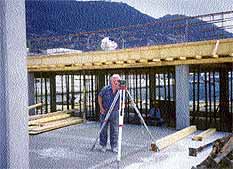
Willie Picardo (outstanding stroke pre and post WWII) lending a hand
|
History had repeated itself after 112 years. The thought of moving the Club's premises elsewhere was again a daunting one. Compounding the predicament were the extremely high costs envisaged. Negotiations with Gibraltar Homes Limited, however, would ultimately yield satisfactory solutions. Their first offer of £175,000 for the surrender of the Club's 99 year lease was turned down by the Club. The former's second offer of £450,000 was more difficult to refuse, and an agreement was then reached to make this sum payable as and when work on their new premises at Europort Road was commenced and, if backed by a private banker's guarantee. This agreed, the 99 year lease over the new premises was issued by Government and, in April 1994, the Club commissioned Mackley Tricon on a Design and Build basis. Eleven months later it was over. After a miserable, dispiriting year, Calpe Rowing Club again had a decent roof over their heads, and a pretty nice one too if I may say! The following few months were spent on external works most of which were entrusted to the same Builders as a separate contract. The total cost of the development was in excess of 500,000, and members were consequently requested to pay an extraordinary reprovisioning payment of £100. Some members, like Eric Ellul, even took it upon themselves to further enhance the new Clubhouse Eric Ellul recollects:
"Many of the members took an active part in the construction of the new clubhouse and in the move which spanned a period of some two years between 1993 and 1995. This period was a particularly busy one for me in my practice and I was unable to make any meaningful contribution other than walking through the shell of the half completed clubhouse and nodding knowingly at meetings held to discuss progress.
In the circumstances, once the clubhouse was completed and the move finalised, I thought it proper to make a belated contribution and decided to donate a mammoth shield of the club to decorate the eastern wall of the clubhouse facing the entrance to the club. The choice of materials came easily to me. It would be of ceramic tiles and the size large enough to cover a sizeable portion of the wall and create an immediate impact and become a proud possession of the club.
The next question was where to have this made. A few enquiries in Spain all pointed to the traditional artesan ceramic designers and manufacturers, Hispalceramica, in Seville. There was some controversy as to which was the genuine of two shields in use at the time and, in the end and having consulted the elders of the club, a decision was taken as to which was the true one.
It needed a few visits to Seville to ensure that they were getting everything right. The workshop was a most impressive place to visit. Part of it is funded by the State and operates as a school of the art of decorative tile making in the highest traditions. Hair from horses' tails alone is used for painting the tiles and this is used in a large bunch tapering to a fine end and held by the painter in his hand rather than between his fingers. Bold and sure strokes are used, even when painting the most intricate detail. Matching colours is an art in itself since, once fired, the colour on the tile will change its hue and tone.
It took some two months for the outline to be drawn and then coloured in and fired in a traditional kiln fuelled by olive tree logs, which produce a short-lived but intense heat. Once ready, the whole thing, numbering over 300 tiles, was brought to Gibraltar and I felt daunted by the sheer size of it and the jigsaw puzzle it involved. Notwithstanding, I was determined to put the shield up on the wall myself, a task I had never got anywhere close to attempting.
The height of the shield is 4 metres and its width at the top is 3.2 metres. I hired some scaffolding, which caused me great concern since I am not one for heights. I had four days in which to put the shield up in order that it would be ready for the first annual dinner at the new clubhouse on 14 November of that year, 1995. I was down at the club on the first morning at 7.00 o'clock. It took me half the morning just to lay out the shield on the ground and set up the scaffolding. I then thoroughly soaked the wall in order that it would not absorb too quickly the paste when applied and set out my starting line, about a quarter of the way up, by nailing a board to the wall across the length of the shield at that height.
Then started the slow, and often, messy business of putting up each individual tile. This meant climbing up the scaffolding with an armful of tiles, putting them up and then repeating the operation. As row after row was completed and I started climbing higher, the scaffolding seemed to become more rickety and my nerve began to falter. Throughout that day and the following day I worked steadily from sunrise to sunset, stopping only for meals and to listen to the sage advice and the many suggestions of members, especially those of the older generation, as to how best the job should be done. I look it all in with appropriate humility.
I think it was during the second day that Luis Russo, my trusted assistant in the later project of La Pergola, came to my assistance. By this time we were virtually completing the tiling and approaching the stage of grouting the finished work and Luis was particularly useful in putting on the grout to the higher areas of the shield, which I felt incapable of ascending to. It must have been some two hours on the fourth day and just before the annual dinner was due to begin when we finally completed the task, gave the shield a last rub down and dismantled the scaffolding with a great deal of difficulty since it appeared to have got used to its assembled form and was reluctant to be dismantled once more into a non-descript pile of tubes and boards.
A quick shower and change into our evening suits and back to admire the now brilliantly illuminated shield. A happy and rewarding moment for me and, I hope, a proud possession for the club and for future generations of members for years to come."
|
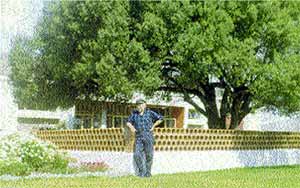
Alfredo (el Pillin) Aonso in front of Olive Tree at Devil's Tongue Clubhouse
|
|
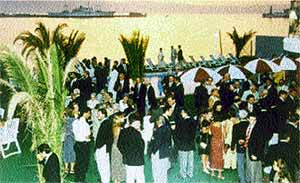
Inauguration of clubhouse at Europort
|
The newly acquired area was treeless and had no green whatsoever. The Club at Montague Basin, on the other hand, had had a massive olive tree planted there 100 years earlier. The tree had been a characteristic feature of the premises for decades, providing shade to all those who sat under it during the scorching summer. It was a magnificent specimen that, with the expert help from the then extant Wild Life Gibraltar and the able assistance of Mackley Tricon, was uprooted from its old environment and replanted at its new home in October 1994, where it continues to flourish to this very day, gaining in rich foliage and beauty.
|

EUROPORT AGREEMENT
Signing of resiting agreement.
Back Row: A Falero (Land Property Services Ltd), The Hon M A Feetham (Minister for Trade & Industry)
Front Row: E B Francis (Vice President), A J Benatar (President), J Desoiza (Gibraltar Homes Ltd)
|
But what of the Club's rowing victories and defeats since its centenary 25 years ago? Leslie Grech, a past Club Captain and present Deputy Captain, recapitulates:
"Many aspects of our sport have changed since we last celebrated our centenary in 1976. Changes in our rowing calendar, the type of boats we row in, the way we train and a greater emphasis on competition abroad.
Off the water the formation of the local governing body G.A.R.A. (Gibraltar Amateur Rowing Association) was a significant event. Its subsequent acceptance by FISA (the world governing body) at the 1984 congress in Lucerne brought in changes in the way we conducted our rowing affairs.
It was during Clive Baker's 15-year term of office as Captain (1982-1997) that GARA was accepted into the International rowing family. The changes that this triggered off were many and varied. In came races over 2000m in shell boats. The Club saw an increase in its fleet; having bought a shell coxed four, a double scull and pair. A number of members also invested in their own single sculling boats.... they all wanted more time on the water! This in turn meant radical changes in the regatta calendar. More races in shell boats together with the traditional regattas over one mile in yolas.
Our present racing programme ranges from December till August of the following year. Racing in yolas and shell boats, catering for juniors from the age of 14 to veterans. The introduction of ladies racing in all these categories has also meant an expansion in the number of active members making use of our boating facilities. Nowadays the Club will fill no less than 7 or 8 competitive crews throughout the season, many of these doubling up to take part in the smallboat events (single scull, double scull, and pair). Year round training is a must if anyone wants to remain competitive. Gone are the days when one started training in March or April and knocked off after the last regatta in October! One phenomenon of this is that some oarsmen have now been successfully competing for the Club at the top level for well over 15 years.
Our inclusion in FISA has meant that we are able to compete in regattas abroad just like any other nation or club. In the last 25 years Calpe Rowing Club have participated with some success at many International events. It was a source of great pride that the majority of the rowing team for the 1986 Commonwealth Games in Edinburgh was made up by CRC oarsmen, with Captain Clive Baker as team leader. Many of these oarsmen later went on to take part in events in Portugal (Obidos), Spain (Malaga) and Seville), Italy (Naro), to mention a few. These competitions and contracts gave us a hunger for success, more exacting training, a greater competitive edge, and a demand for better equipment as we sought to improve. More recently the Club have been a regular participant at the UK National Championships. Last year the highlight was a 4th place in the final of Junior 15 single sculls. This year we have already had wins at the Docklands Regatta and Kingston Regatta (London) in Junior 15 single sculls, double sculls and quad sculls. These boys have all been the product of the Club's annual summer rowing courses. The Club runs these during the summer holidays as a means of identifying talent at a young age. It also guarantees a steady flow of rowers into the competition pool.
The past four years have seen the Club dominate the local rowing scene. Worthy of mention is the first crew who now hold the course records in yola for both 1 mile and 2000m. The girls crew have only lost a handful of races in the last four years. Our present 14 and 15 year olds look set to dominate in the future judging by this year's results. Let's keep pulling together for another 25 years!"
August 2001 will see Calpe Rowing Club celebrate its 125th anniversary in style. In as many years hence, members will perhaps browse through the annuals of this Club's proud history and remember this very auspicious occasion just as we ourselves now look back and remember the Club's forefathers.
|
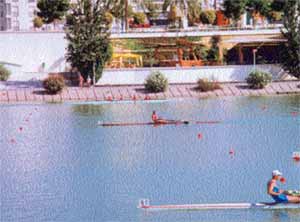
L Grech becoming World Masters Gold Medalist in 1997
|
|
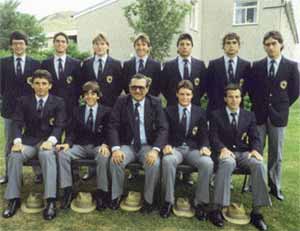
1986 Commonwealth contingent
|
|
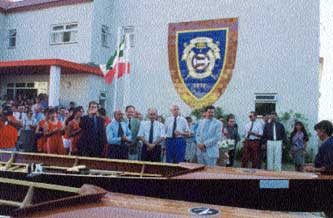
Christening of Speedy III and Swift V in 1997.
|
|

Winners of the First Sacarello CC in 1984
|

Present crop of youngsters 2001
|
|

Winners at Nottingham Sprint Regatta in Coxed Fours (1999)
E Vella, S Cabezutto, S Grech, E Azopardi.
L Grech Jr Singer Sculls, Junior 14.
|
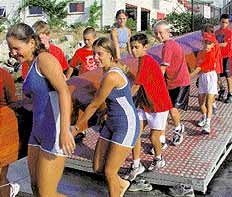
Launching yola from pontoon
|
|
